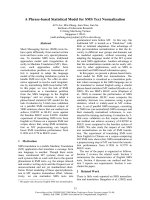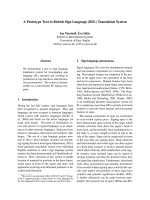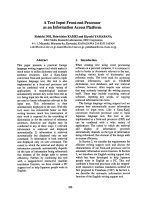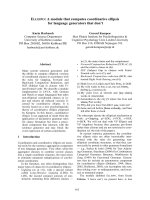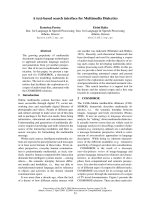Báo cáo khoa học: "A Text Understander that Learns" doc
Bạn đang xem bản rút gọn của tài liệu. Xem và tải ngay bản đầy đủ của tài liệu tại đây (672.32 KB, 7 trang )
A Text Understander that Learns
Udo Hahn &: Klemens Schnattinger
Computational Linguistics Lab, Freiburg University
Werthmannplatz 1, D-79085 Freiburg, Germany
{hahn, schnatt inger}@col ing. uni-freiburg, de
Abstract
We introduce an approach to the automatic ac-
quisition of new concepts fi'om natural language
texts which is tightly integrated with the under-
lying text understanding process. The learning
model is centered around the 'quality' of differ-
ent forms of linguistic and conceptual evidence
which underlies the incremental generation and
refinement of alternative concept hypotheses,
each one capturing a different conceptual read-
ing for an unknown lexical item.
1 Introduction
The approach to learning new concepts as a
result of understanding natural language texts
we present here builds on two different sources
of evidence the prior knowledge of the do-
main the texts are about, and grammatical con-
structions in which unknown lexical items oc-
cur. While there may be many reasonable inter-
pretations when an unknown item occurs for the
very first time in a text, their number rapidly
decreases when more and more evidence is gath-
ered. Our model tries to make explicit the rea-
soning processes behind this learning pattern.
Unlike the current mainstream in automatic
linguistic knowledge acquisition, which can be
characterized as quantitative, surface-oriented
bulk processing of large corpora of texts (Hin-
dle, 1989; Zernik and Jacobs, 1990; Hearst,
1992; Manning, 1993), we propose here a
knowledge-intensive
model of concept learning
from
few,
positive-only examples that is tightly
integrated with the non-learning mode of text
understanding. Both learning and understand-
ing build on a given core ontology in the format
of terminological assertions and, hence, make
abundant use of terminological reasoning. The
'plain' text understanding mode can be consid-
ered as the instantiation and continuous filling
d~udr s,y ~
trw
~
Hyl~si~
space-
j
Hyputhcsis
t spal.'c-n I Q*mlifi~r
Q*mlity
~,l~*Ine
Figure 1: Architecture of the Text Learner
of roles with respect to
single concepts
already
available in the knowledge base. Under learning
conditions, however, a
set of alternative concept
hypotheses
has to be maintained for each un-
known item, with each hypothesis denoting a
newly created conceptual interpretation tenta-
tively associated with the unknown item.
The underlying methodology is summarized
in Fig. 1. The
text parser
(for an overview, cf.
BrSker et al. (1994)) yields information from
the grammatical constructions in which an un-
known lexical item (symbolized by the black
square) occurs in terms of the corresponding
de-
pendency parse tree.
The kinds of syntactic con-
structions (e.g., genitive, apposition, compara-
tive), in which unknown lexical items appear,
are recorded and later assessed relative to the
credit they lend to a particular hypothesis. The
conceptual interpretation of parse trees involv-
ing unknown lexical items in the
domain knowl-
edge base
leads to the derivation of
concept hy-
potheses,
which are further enriched by concep-
tual annotations. These reflect structural pat-
terns of consistency, mutual justification, anal-
ogy, etc. relative to already available concept
descriptions in the domain knowledge base or
other hypothesis spaces. This kind of initial ev-
idence, in particular its predictive "goodness"
for the learning task, is represented by corre-
sponding sets of
linguistic
and
conceptual qual-
476
iSyntax Semantics
CMD C ~ QD z
CuD CZuD z
VR.C {d e A z [ RZ(d) C_ C z}
RnS R z nS z
cln
{(d,d')en
z l d e C z}
RIG {(d, d') • n z I d' • C z)
Table l: Some Concept and
Role Terms
Axiom Semantics
A - C A z = C z
a : C a z E
C z
Q - R QZ = RZ
a R b (a z, b z) E R z
Table 2: Axioms for
Concepts and Roles
ity labels. Multiple concept hypotheses for each
unknown lexical item are organized in terms of
corresponding hypothesis spaces, each of which
holds different or further specialized conceptual
readings.
The quality machine estimates the overall
credibility of single concept hypotheses by tak-
ing the available set of quality labels for each
hypothesis into account. The final computa-
tion of a preference order for the entire set of
competing hypotheses takes place in the qual-
ifier, a terminological classifier extended by an
evaluation metric for quality-based selection cri-
teria. The output of the quality machine is a
ranked list of concept hypotheses. The ranking
yields, in decreasing order of significance, either
the most plausible concept classes which classify
the considered instance or more general concept
classes subsuming the considered concept class
(cf. Schnattinger and Hahn (1998) for details).
2 Methodological Framework
In this section, we present the major method-
ological decisions underlying our approach.
2.1 Terminological Logics
We use a standard terminological, KL-ONE-
style concept description language, here referred
to as C:D£ (for a survey of this paradigm, cf.
Woods and Schmolze (1992)). It has several
constructors combining atomic concepts, roles
and individuals to define the terminological the-
ory of a domain. Concepts are unary predicates,
roles are binary predicates over a domain A,
with individuals being the elements of A. We
assume a common set-theoretical semantics for
C7)£ - an interpretation Z is a function that
assigns to each concept symbol (the set A) a
subset of the domain A, Z : A -+ 2 n, to each
role symbol (the set P) a binary relation of A,
Z : P + 2 ~×n, and to each individual symbol
(the set I) an element of A, Z : I + A.
Concept terms and role terms are defined in-
ductively. Table 1 contains some constructors
and their semantics, where C and D denote con-
cept terms, while R and S denote roles. R z (d)
represents the set of role fillers of the individual
d, i.e., the set of individuals e with (d, e) E R z.
By means of terminological axioms (for a sub-
set, see Table 2) a symbolic name can be intro-
duced for each concept to which are assigned
necessary and sufficient constraints using the
definitional operator '"= . A finite set of such
axioms is called the terminology or TBox. Con-
cepts and roles are associated with concrete in-
dividuals by assertional axioms (see Table 2; a, b
denote individuals). A finite set of such axioms
is called the world description or ABox. An in-
terpretation Z is a model of an ABox with re-
gard to a TBox, iff Z satisfies the assertional
and terminological axioms.
Considering, e.g., a phrase such as 'The
switch of the Itoh-Ci-8 ', a straightforward
translation into corresponding terminological
concept descriptions is illustrated by:
(el) switch.1 : SWITCH
(P2) Itoh-Ci-8 HAS-SWITCH switch.1
(P3)
HAS-SWITCH
(OuTPUTDEV LJ INPUTDEV U IHAS-PARTISwITCH
STORAGEDEV t3 COMPUTER)
Assertion P1 indicates that the instance
switch.1 belongs to the concept class SWITCH.
P2 relates Itoh-Ci-8 and switch.1 via the re-
lation HAS-SWITCH. The relation HAS-SWITCH
is defined, finally, as the set of all
HAS-PART
relations which have their domain restricted to
the disjunction of the concepts OUTPUTDEV,
INPUTDEV,
STORAGEDEV
or COMPUTER
and
their range restricted to
SWITCH.
In order to represent and reason about con-
cept hypotheses we have to properly extend the
formalism of C~£. Terminological hypotheses,
in our framework, are characterized by the fol-
lowing properties: for all stipulated hypotheses
(1) the same domain A holds, (2) the same con-
cept definitions are used, and (3) only different
assertional axioms can be established. These
conditions are sufficient, because each hypoth-
esis is based on a unique discourse entity (cf.
(1)), which can be directly mapped to associ-
ated instances (so concept definitions are stable
(2)). Only relations (including the ISA-relation)
among the instances may be different (3).
477
Axiom Semantics
(a : C)h a z E C zn
(aRb)h (a z,b z) ER zh
Table 3: Axioms in
CDf hvp°
Given these constraints, we may annotate
each assertional axiom of the form 'a : C' and
'a R b' by a corresponding hypothesis label h so
that (a :
C)h
and
(a R b)h
are valid terminolog-
ical expressions. The extended terminological
language (cf. Table 3) will be called
CD£ ~y~°.
Its semantics is given by a special interpreta-
tion function
Zh
for each hypothesis h, which is
applied to each concept and role symbol in the
canonical way:
Zh
: A + 2zx;
Zh
: P + 2 AxA.
Notice that the instances a, b are interpreted by
the interpretation function Z, because there ex-
ists only one domain £x. Only the interpretation
of the concept symbol C and the role symbol R
may be different in each hypothesis h.
Assume that we want to represent two of the
four concept hypotheses that can be derived
from (P3),
viz. Itoh-Ci-Sconsidered
as a storage
device or an output device. The corresponding
ABox expressions are then given by:
( Itoh-Ci-8
HAS-SWITCH
switch.1)h,
(Itoh-Ci-8
: STORAGEDEV)h 1
( Itoh-C i-8
HAS-SWITCH
switch.1)h2
(Itoh-Ci-8
: OUTPUTDEV)h~
The semantics associated with this ABox
fi'agment has the following form:
~h, (HAS-SWITCH) -"
{(Itoh-Ci-8, switch.l)},
Zhx (STORAGEDEV) m
{Itoh-Ci-8},
Zha (OuTPUTDEV) "- 0
Zh~(HAS-SWITCH) :
{(Itoh-Ci-8, switch.l)},
Zh2(STORAGEDEV) = 0,
:~h (OUTPUTDEV) :
{Itoh-Ci-8}
2.2
Hypothesis Generation
Rules
As mentioned above, text parsing and con-
cept acquisition from texts are tightly coupled.
Whenever, e.g., two nominals or a nominal and
a verb are supposed to be syntactically related
in the regular parsing mode, the semantic in-
terpreter simultaneously evaluates the concep-
tual compatibility of the items involved. Since
these reasoning processes are fully embedded in
a terminological representation system, checks
are made as to whether a concept denoted by
one of these objects is allowed to fill a role of
the other one. If one of the items involved is
unknown, i.e., a lexical and conceptual gap is
encountered, this interpretation mode generates
initial concept hypotheses about the class mem-
bership of the unknown object, and, as a conse-
quence of inheritance mechanisms holding for
concept taxonomies, provides conceptual role
information for the unknown item.
Given the structural foundations of termi-
nological theories, two dimensions of concep-
tual learning can be distinguished the tax-
onomic one by which new concepts are located
in conceptual hierarchies, and the aggregational
one by which concepts are supplied with clus-
ters of conceptual relations (these will be used
subsequently by the terminological classifier to
determine the current position of the item to
be learned in the taxonomy). In the follow-
ing, let
target.con
be an unknown concept de-
noted by the corresponding lexical item
tar-
get.lex, base.con
be a given knowledge base con-
cept denoted by the corresponding lexical item
base.lex,
and let
target.lex
and
base.lex
be re-
lated by some dependency relation. Further-
more, in the hypothesis generation rules below
variables are indicated by names with leading
'?'; the operator TELL is used to initiate the
creation of assertional axioms in
C7)£ hyp°.
Typical linguistic indicators that can be ex-
ploited for
taxonomic
integration are apposi-
tions
(' the printer
@A@ '), exemplification
phrases
(' printers like the @A @ ')
or nomi-
nal compounds
( ' the @A @ printer 1.
These
constructions almost unequivocally determine
'@A@'
(target.lex)
when considered as a proper
name 1 to denote an instance of a PRINTER
(tar-
get.con),
given its characteristic dependency re-
lation to
'printer' (base.lex),
the conceptual cor-
relate of which is the concept class PRINTER
(base.con).
This conclusion is justified indepen-
dent of conceptual conditions, simply due to
the
nature of these linguistic constructions.
The generation of corresponding concept hy-
potheses is achieved by the rule sub-hypo (Ta-
ble 4). Basically, the type of
target.con
is carried
over from
base.con
(function type-of). In addi-
tion, the syntactic
label
is asserted which char-
acterizes the grammatical construction figuring
as the structural source for that particular hy-
1Such a part-of-speech hypothesis can be derived
from the inventory of valence and word order specifi-
cations underlying the dependency grammar model we
use (BrSker et
al., 1994).
478
sub-hypo (target.con, base.con, h, label)
?type := type-of(base.con)
TELL (target.con : ?type)h
add-label((target.con : ?type)h ,label)
Table 4: Taxonomic Hypothesis Generation Rule
pothesis (h denotes the identifier for the selected
hypothesis space), e.g.,
APPOSITION,
EXEMPLI-
FICATION,
or NCOMPOUND.
The aggregational dimension of terminologi-
cal theories is addressed, e.g., by grammatical
constructions causing case frame assignments.
In the example ' @B@ is equipped with 32 MB
of RAM ', role filler constraints of the verb
form 'equipped' that relate to its PATIENT role
carry over to '@B~'. After subsequent seman-
tic interpretation of the entire verbal complex,
'@B@' may be anything that can be equipped
with memory. Constructions like prepositional
phrases ( ' @C@ from IBM ') or genitives ('
IBM's @C@ ~ in which either target.lex or
base.lex occur as head or modifier have a simi-
lar effect. Attachments of prepositional phrases
or relations among nouns in genitives, however,
open a wider interpretation space for '@C~'
than for '@B~', since verbal case frames provide
a higher role selectivity than PP attachments
or, even more so, genitive NPs. So, any concept
that can reasonably be related to the concept
IBM will be considered a potential hypothesis
for '@C~-", e.g., its departments, products, For-
tune 500 ranking.
Generalizing from these considerations, we
state a second hypothesis generation rule which
accounts for aggregational patterns of concept
learning. The basic assumption behind this
rule, perm-hypo (cf. Table 5), is that target.con
fills (exactly) one of the n roles of base.con it
is currently permitted to fill (this set is deter-
mined by the function porto-filler). Depend-
ing on the actual linguistic construction one en-
counters, it may occur, in particular for PP
and NP constructions, that one cannot decide
on the correct role yet. Consequently, several
alternative hypothesis spaces are opened and
target.co~ is assigned as a potential filler of
the i-th role (taken from ?roleSet, the set of
admitted roles) in its corresponding hypothesis
space. As a result, the classifier is able to de-
rive a suitable concept hypothesis by specializ-
ing target.con according to the value restriction
of base.con's i-th role. The function member-of
?roleSet :=perm-f iller( target.con, base.con, h)
?r := [?roleSet I
FORALL ?i
:=?r DOWNTO 1 DO
?rolel := member-of ( ?roleSet )
?roleSet :=?roleSet \ {?rolei}
IF ?i = 1
THEN ?hypo := h
ELSE ?hypo := gen-hypo(h)
TELL (base.con ?rolei target.con)?hypo
add-label ((base.con ?rolei target.con)?hypo, label )
Table 5: Aggregational Hypothesis Generation Rule
selects a role from the set ?roleSet;
gen-hypo
creates a new hypothesis space by asserting
the given axioms of h and outputs its identi-
fier. Thereupon, the hypothesis space identified
by ?hypo is augmented through a TELL op-
eration by the hypothesized assertion. As for
sub-hypo, perm-hypo
assigns a syntactic qual-
ity label (function add-label) to each i-th hy-
pothesis indicating the type of syntactic con-
struction in which target.lex and base.lex are
related in the text, e.g.,
CASEFRAME,
PPAT-
TACH or GENITIVENP.
Getting back to our example, let us assume
that the target Itoh-Ci-8 is predicted already as
a PRODUCT as a result of preceding interpreta-
tion
processes, i.e., Itoh-Ci-8 : PRODUCT holds.
Let PRODUCT be defined as:
PRODUCT
VHAS-PART.PHYSICALOBJECT I-1 VHAS-SIZE.SIZE ["1
VHAS-PRICE.PRICE i-I VHAS-WEIGHT.WEIGHT
At this level of conceptual restriction, four
roles have to be considered for relating the tar-
get Itoh-Ci-8 - as a tentative PRODUCT
-
to
the base concept SWITCH when interpreting the
phrase 'The switch of the Itoh-Ci-8 '. Three of
them,
HAS-SIZE, HAS-PRICE, and HAS-WEIGHT,
are ruled out due to the violation of a simple
integrity constraint ('switch'does not denote a
measure unit). Therefore, only the role
HAS-
PART
must be considered in terms of the expres-
sion Itoh-Ci-8 HAS-PART switch.1 (or, equiva-
lently, switch.1
PART-OF
Itoh-Ci-8).
Due to the
definition of
HAS-SWITCH (cf.
P3, Subsection
2.1), the instantiation of HAS-PART is special-
ized to HAS-SWITCH by the classifier, since the
range of the HAS-PART relation is already re-
stricted to SWITCH (P1). Since the classifier ag-
gressively pushes hypothesizing to be maximally
specific, the disjunctive concept referred to in
479
the domain restrictiou of the role HAS-SWITCH
is split into four distinct hypotheses, two of
which are sketched below. Hence, we assume
Itoh-Ci-8
to deuote either a STORAGEDEvice
or an OUTPUTDEvice or an INPUTDEvice or a
COMPUTER (note that we also include parts of
the IS-A hierarchy in the example below).
(Itoh-Ci-8
: STORAGEDEV)h,,
(Itoh-Ci-8
: DEVICE)h~, ,
( Itoh-C i-8
HAS-SWITCH
switch.1)h~
(Itoh-Ci-8
: OUTPUTDEv)h~,
(Itoh-Ci-8
: DEVICE)h2, ,
(Itoh-Ci-8
HAS-SWITCH
swilch.1)h~,
2.3 Hypothesis Annotation Rules
In this section, we will focus on the quality as-
sessment of concept hypotheses which occurs at
the knowledge base level only; it is due to the
operation of hypothesis annotation rules which
continuously evaluate the hypotheses that have
been derived from linguistic evidence.
The M-Deduction rule (see Table 6) is trig-
gered for any repetitive assignment of the same
role filler to one specific conceptual relation that
occurs in different hypothesis spaces. This rule
captures the assu,nption that a role filler which
has been
multiply
derived at different occasions
must be granted more strength than one which
has been derived at a single occasion only.
EXISTS
Ol,O2, R, hl,h~. :
(Ol
R o2)hl
A (Ol
R o2)h~ A hi ~ h~
TELL (ol R o~_)h~ : M-DEDUCTION
Table 6: The Rule M-Deduction
Considering our example at the end of subsec-
tion 2.2, for
'Itoh-Ci-8'
the concept hypotheses
STORAGEDEV and OUTPUTDEV were derived
independently of each other in different hypoth-
esis spaces. Hence, DEVICE as their common
superconcept has been multiply derived by the
classifier in each of these spaces as a result of
transitive closure computations, too. Accord-
ingly, this hypothesis is assigned a high degree
of confidence by the classifier which derives the
conceptual quality label M-DEDUCTION:
(Itoh-Ci-8
: DEVICE)hi A
(Itoh-Ci-8
: DEVICE)h~
=:=> (Itoh-Ci-8
: DEVICE)hi : M-DEDUCTION
The C-Support rule (see Table 7) is triggered
whenever, within the same hypothesis space,
a hypothetical relation, RI, between two in-
stances can be justified by another relation, R2,
involving the same two instances, but where the
role fillers occur in 'inverted' order (R1 and R2
need not necessarily be semantically inverse re-
lations, as with
'buy'
and
'sell~.
This causes
the generation of the quality label
C-SuPPORT
which captures the inherent symmetry between
concepts related via quasi-inverse relations.
EXISTS Ol, 02, R1, R2, h :
(ol R1 o2)h ^ (02 R2 ol)h ^ ftl # R~
~=~
TELL (Ol R1 o2)h : C-SuPPORT
Table 7: The Rule C-Support
Example:
(Itoh
SELLS
ltoh-Ci-8)h A
(Itoh-Ci-8
DEVELOPED-BY
Itoh)h
(ltoh
SELLS
ltoh-Ci-8)h
: C-SuPPORT
Whenever an already filled conceptual rela-
tion receives an additional, yet different role
filler in the same hypothesis space, the Add-
Filler rule is triggered (see Table 8). This
application-specific rule is particularly suited to
our natural language understanding task and
has its roots in the distinction between manda-
tory and optio,lal case roles for (ACTION) verbs.
Roughly, it yields a negative assessment in
terms of the quality label ADDFILLER for any
attempt to fill the same mandatory case role
more than once (unless coordinations are in-
volved). Iu contradistinction, when the same
role of a non-ACTION concept (typically de-
noted by nouns) is multiply filled we assign the
positive quality label
SUPPORT,
since it reflects
the conceptual proximity a relation induces on
its component fillers, provided that they share
a common, non-ACTION concept class.
EXISTS 01,02, 03, R, h :
(01 R
02)h
A (01 R 03)h A (01 : ACTION)h ===V
I TELL (01 R
o~_)h
: ADDFILLER
Table 8: The Rule AddFiller
We give examples both for the assignmeut of
an ADDFILLER as well as for a SUPPORT label:
Examples:
(produces.1
: ACTION)h A
(produces.1
AGENT
ltoh)h A
(produces.1
AGENT
IBM)h
(produces.1
AGENT
Itoh)h
: ADDFILLER
(ltoh-Ci-8
: PRINTER)h A
(Itoh-Ct
: PRINTER)h A
(Itoh
SELLS
Itoh-Ci-8)h A (Itoh
SELLS
Itoh-Ct)h A
(ltoh
: -~AcTION)h
(Itoh-Ci-8
: PRINTER)h : SUPPORT
480
2.4 Quality Dimensions
The criteria from which concept hypotheses
are derived differ in the dimension from which
they are drawn (grammatical vs. conceptual ev-
idence), as well as the strength by which they
lend support to the corresponding hypotheses
(e.g., apposition vs. genitive, multiple deduc-
tion vs. additional role filling, etc.). In order
to make these distinctions explicit we have de-
veloped a "quality calculus" at the core of which
lie the definition of and inference rules for qual-
ity labels (cf. Schnattinger and Hahn (1998) for
more details). A design methodology for specific
quality calculi may proceed along the follow-
ing lines: (1) Define the dimensions from which
quality labels can be drawn. In our application,
we chose the set I:Q := {ll, , Ira} of linguistic
quality labels and CQ := {cl, ,c~} of con-
ceptual quality labels. (2) Determine a partial
ordering p among the quality labels from one di-
mension reflecting different degrees of strength
among the quality labels. (3) Determine a total
ordering among the dimensions.
In our application, we have empirical evi-
dence to grant linguistic criteria priority over
conceptual ones. Hence, we state the following
constraint: Vl E LQ, Vc E CQ : l >p c
The dimension I:Q. Linguistic quality labels
reflect structural properties of phrasal patterns
or discourse contexts in which unknown lexi-
cal items occur 2 we here assume that the
type of grammatical construction exercises a
particular interpretative force on the unknown
item and, at the same time, yields a particu-
lar level of credibility for the hypotheses being
derived. Taking the considerations from Sub-
section 2.2 into account, concrete examples of
high-quality labels are given by APPOSITION or
NCOMPOUND labels. Still of good quality but
already less constraining are occurrences of the
unknown item in
a CASEFRAME
construction.
Finally, in a PPATTACH or GENITIVENP con-
struction the unknown lexical item is still less
constrained. Hence, at the quality level, these
latter two labels (just as the first two labels we
considered) form an equivalence class whose el-
ements cannot be further discriminated. So we
end up with the following quality orderings:
2In the future, we intend to integrate additional types
of constraints, e.g., quality criteria reflecting the degree
of completeness
vs.
partiality of the parse.
NCOMPOUND
p
APPOSITION
NCOMPOUND >p CASEFRAME
APPOSITION >p CASEFRAME
CASEFRAME >p GENITIVENP
CASEFRAME >p PPATTACH
GENITIVENP =p PPATTACH
The dimension CQ. Conceptualquality labels
result from comparing the conceptual represen-
tation structures of a concept hypothesis with
already existing representation structures in the
underlying domain knowledge base or other con-
cept hypotheses from the viewpoint of struc-
tural similarity, compatibility, etc. The closer
the match, the more credit is lent to a hypoth-
esis. A very positive conceptual quality label,
e.g., is
M-DEDUCTION,
whereas ADDFILLER is
a negative one. Still positive strength is ex-
pressed by SUPPORT
or C-SuPPORT,
both being
indistinguishable, however, from a quality point
of view. Accordingly, we may state:
M-DEDUCTION >p SUPPORT
~{-DEDUCTION >p C-SuPPORT
SUPPORT p C-SuPPORT
SUPPORT >p ADDFILLEK
C-SuPPORT >p ADDFILLER
2.5 Hypothesis
Ranking
Each new clue available for a target concept to
be learned results in the generation of additional
linguistic or conceptual quality labels. So hy-
pothesis spaces get incrementally augmented by
quality statements. In order to select the most
credible one(s) among them we apply a two-step
procedure (the details of which are explained
in Schnattinger and Hahn (1998)). First, those
concept hypotheses are chosen which have ac-
cumulated the greatest amount of high-quality
labels according to the linguistic dimension £:Q.
Second, further hypotheses are selected from
this linguistically plausible candidate set based
on the quality ordering underlying CQ.
We have also made considerable efforts to
evaluate the performance of the text learner
based on the quality calculus. In order to ac-
count for the incrementality of the learning pro-
cess, a new evaluation measure capturing the
system's on-line learning accuracy was defined,
which is sensitive to taxonomic hierarchies. The
results we got were consistently favorable, as
our system outperformed those closest in spirit,
CAMILLE (Hastings, 1996) and ScIsoR (Rau et
481
al., 1989), by a gain in accuracy on the or-
der of 8%. Also, the system requires relatively
few hypothesis spaces (2 to 6 on average) and
prunes the concept search space radically, re-
quiring only a few examples (for evaluation de-
tails, cf. Hahn and Schnattinger (1998)).
3 Related Work
We are not concerned with lexical acquisition
from
very large
corpora using surface-level collo-
cational data as proposed by Zernik and Jacobs
(1990) and Velardi et al. (1991), or with hy-
ponym extraction based on entirely syntactic
criteria as in Hearst (1992) or lexico-semantic
associations (e.g., Resnik (1992) or Sekine et al.
(1994)). This is mainly due to the fact that
these studies aim at a shallower level of learn-
ing (e.g., selectional restrictions or thematic re-
lations of verbs), while our focus is on much
more fine-grained conceptual knowledge (roles,
role filler constraints, integrity conditions).
Our approach bears a close relationship, how-
ever, to the work of Mooney (1987), Berwick
(1989), Rau et al. (1989), Gomez and Segami
(1990), and Hastings (1996), who all aim at the
automated learning of word meanings from con-
text using a knowledge-intensive approach. But
our work differs from theirs in that the need to
cope with
several competing
concept hypotheses
and to aim at a
reason-based selection
in terms
of the
quality
of arguments is not an issue in
these studies. Learning from real-world texts
usually provides the learner with only sparse
and fragmentary evidence, such that multiple
hypotheses are likely to be derived and a need
for a hypothesis evaluation arises.
4 Conclusion
We have introduced a solution for the semantic
acquisition problem on the basis of the auto-
matic processing of expository texts. The learn-
ing methodology we propose is based on the
incremental assignment and evaluation of the
quality of linguistic and conceptual evidence for
emerging concept hypotheses. No specialized
learning algorithm is needed, since learning is
a reasoning task carried out by the classifier
of a terminological reasoning system. However,
strong heuristic guidance for selecting between
plausible hypotheses comes from linguistic and
conceptual quality criteria.
Acknowledgements. We would like to thank
our colleagues in the CLIF group for fruitful discus-
sions, in particular Joe Bush who polished the text
as a native speaker. K. Schnattinger is supported by
a grant from DFG (Ha 2097/3-1).
References
R. Berwick. 1989. Learning word meanings from
examples. In D. Waltz, editor,
Semantic Struc-
tures.,
pages 89-124. Lawrence Erlbaum.
N. BrSker, U. Hahn, and S. Schacht. 1994.
Concurrent lexicalized dependency parsing: the
PARSETALK model. In
Proc. of the COLING'94.
Vol. I,
pages 379-385.
F. Gomez and C. Segami. 1990. Knowledge acqui-
sition from natural language for expert systems
based on classification problem-solving methods.
Knowledge Acquisition,
2(2):107-128.
U. Hahn and K. Schnattinger. 1998. Towards text
knowledge engineering. In
Proc. of the AAAI'98.
P. Hastings. 1996. Implications of an automatic lex-
ical acquisition system. In S. Wermter, E. Riloff,
and G. Scheler, editors,
Connectionist, Statistical
and Symbolic Approaches to Learning for Natural
Language Processing,
pages 261-274. Springer.
M. Hearst. 1992. Automatic acquisition of hy-
ponyms from large text corpora. In
Proc. of the
COLING'92. Vol.2,
pages 539-545.
D. Hindle. 1989. Acquiring disambiguation rules
from text. In
Proc. of the A CL'89,
pages 26-29.
C. Manning. 1993. Automatic acquisition of large
subcategorization dictionary from corpora. In
Proc. of the A CL'93,
pages 235-242.
R. Mooney. 1987. Integrated learning of words
and their underlying concepts. In
Proe. of the
CogSci'87,
pages 974-978.
L. Rau, P. Jacobs, and U. Zernik. 1989. Information
extraction and text summarization using linguis-
tic knowledge acquisition.
Information Processing
Management,
25(4):419-428.
P. Resnik. 1992. A class-based approach to lexical
discovery. In
Proe. of the A CL '92,
pages 327-329.
K. Schnattinger and U. Hahn. 1998. Quality-based
learning. In
Proc. of the ECAI'98,
pages 160-164.
S. Sekine, J. Carroll, S. Ananiadou, and J. Tsujii.
1994. Automatic learning for semantic colloca-
tion. In
Proc. of the ANLP'94,
pages 104-110.
P. Velardi, M. Pazienza, and M. Fasolo. 1991.
How to encode semantic knowledge: a method for
meaning representation and computer-aided ac-
quisition.
Computational Linguistics,
17:153-170.
W. Woods and J. Schmolze. 1992. The KL-ONE
family.
Computers ~ Mathematics with Applica-
tions,
23(2/5):133-177.
U. Zernik and P. Jacobs. 1990. Tagging for learn-
ing: collecting thematic relations from corpus. In
Proc. of the COLING'90. Vol. 1,
pages 34-39.
482


